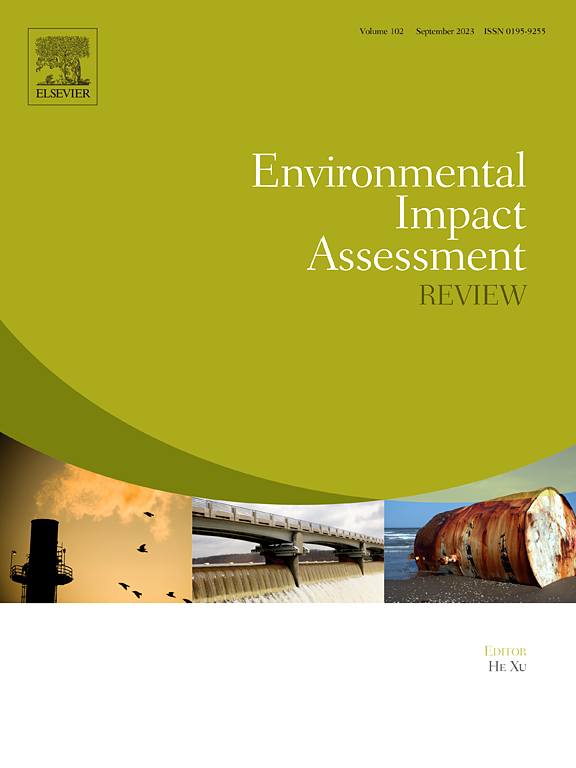Integrating biodiversity and ecosystem services in land use change assessment through sustainability indicator
IF 9.8
1区 社会学
Q1 ENVIRONMENTAL STUDIES
引用次数: 0
Abstract
While agricultural and urban expansion continue to drive land use change (LUC), their long-term impacts on ecological integrity and human well-being remain inadequately addressed due to the lack of robust intergenerational sustainability frameworks. This study introduces a novel indicator-based approach to bridge this gap. It begins with a comprehensive review of biodiversity - ecosystem service (BD-ES) relationships to construct two composite indicators (CIs); CI Loss, which quantifies collective BD-ES losses resulting from the conversion of natural forest to agricultural and urban areas under three management intensities (minimum, limited and intense), and CI Capacity, which measures the existing LU capacity to support and supply BD-ES. These CIs can be incorporated into broader indicator-based environment system analyses. To evaluate intergenerational LUC sustainability across temporal and spatial scales, the CIs are integrated into the land aspect of Resources Time Footprint (RTF) indicator. RTF evaluates resource occupancy rates relative to human lifespan thresholds across multiple sustainability dimensions, including material scarcity, human intervention intensity, social and ecological carrying capacities, and intergenerational fairness. The efficacy of this approach is assessed through two case studies: (1) LU transitions from natural forests to agricultural and urban areas, and (2) a hypothetical sugarcane-bagasse-based electricity generation scenario in Bhutan. The multidimensional linkages between BD and ES reveal that no single BD metric serves as an adequate surrogate for ESs. CI Loss values vary both within and between LU types, with agricultural LUC showing increasing impact across intensities (0.15–0.53), and urban LUC consistently exhibiting higher losses (0.39–1.00). CI Capacity is highest in mixed forests (1.00) and lowest in burnt areas (0.01). The first case reveals spatial variations in RTF (1–8 years/capita) driven by social and ecological factors, while the second highlights a relatively sustainable process (3.75 years) with notable trade-offs across aspects and districts. By addressing ecological integrity and long-term human well-being, this research supports more informed and sustainable LU planning and management.

通过可持续性指标将生物多样性和生态系统服务纳入土地利用变化评估
虽然农业和城市扩张继续推动土地利用变化(LUC),但由于缺乏强有力的代际可持续性框架,它们对生态完整性和人类福祉的长期影响仍未得到充分解决。本研究引入了一种新的基于指标的方法来弥合这一差距。本文首先对生物多样性-生态系统服务(BD-ES)关系进行了全面综述,构建了两个复合指标(ci);CI损失,量化在三种管理强度(最小、有限和强烈)下天然林向农业和城市地区转化所造成的生物多样性生态系统的集体损失;CI能力,衡量现有生态系统支持和供应生物多样性生态系统的能力。这些ci可以纳入更广泛的基于指标的环境系统分析。为了在时间和空间尺度上评价代际土地利用变化的可持续性,将ci整合到资源时间足迹(RTF)指标的土地方面。RTF在多个可持续性维度上评估相对于人类寿命阈值的资源占用率,包括物质稀缺性、人类干预强度、社会和生态承载能力以及代际公平。通过两个案例研究评估了这一方法的有效性:(1)从天然森林到农业和城市地区的低碳过渡,以及(2)假设不丹的甘蔗-甘蔗蔗基发电情景。BD和ES之间的多维联系表明,没有单一的BD指标可以作为ESs的适当替代品。CI损失值在不同类型的土地覆盖范围内和不同类型之间都有所不同,农业土地覆盖范围在不同强度下的影响越来越大(0.15-0.53),而城市土地覆盖范围的损失一直较高(0.39-1.00)。混交林的CI容量最高(1.00),火烧区最低(0.01)。第一个案例揭示了RTF在社会和生态因素驱动下的空间差异(1-8年/人均),而第二个案例则强调了一个相对可持续的过程(3.75年),在各个方面和地区之间存在显著的权衡。通过解决生态完整性和长期人类福祉,本研究支持更明智和可持续的土地利用规划和管理。
本文章由计算机程序翻译,如有差异,请以英文原文为准。
求助全文
约1分钟内获得全文
求助全文
来源期刊

Environmental Impact Assessment Review
ENVIRONMENTAL STUDIES-
CiteScore
12.60
自引率
10.10%
发文量
200
审稿时长
33 days
期刊介绍:
Environmental Impact Assessment Review is an interdisciplinary journal that serves a global audience of practitioners, policymakers, and academics involved in assessing the environmental impact of policies, projects, processes, and products. The journal focuses on innovative theory and practice in environmental impact assessment (EIA). Papers are expected to present innovative ideas, be topical, and coherent. The journal emphasizes concepts, methods, techniques, approaches, and systems related to EIA theory and practice.
 求助内容:
求助内容: 应助结果提醒方式:
应助结果提醒方式:


